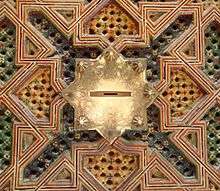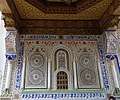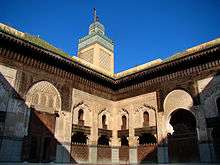Zaouia Moulay Idriss II

Coordinates: 34°03′53.45″N 4°58′29.00″W / 34.0648472°N 4.9747222°WThe Zaouia of Moulay Idriss II is a zaouia (a shrine and religious complex; also spelled zawiya) in Fez, Morocco. It is dedicated to and contains the tomb of Idris II (or Moulay Idris II when including his sharifian title), who ruled Morocco from 807 to 828 and is considered the main founder of the city of Fes and of the first Moroccan Islamic state.[1][2] It is located in the heart of Fes el-Bali, the UNESCO-listed old medina of Fez.
History and significance of Moulay Idriss II
Idris II, born in 791, was the son and successor of Idris I. Idris I was a descendant of the Prophet Muhammad who fled from Abbasid-controlled territory after the Battle of Fakh because he had supported the defeated pro-Shi'a rebels. He used his prestige as a descendant of the Prophet to forge an alliance with local Berbers in 789 and quickly became the most important religious and political leader in the region. He died soon after in 791, just before his son Idris (II) was born. After Idris II officially took over his position as ruler in 803 he significantly expanded the authority of the new Idrisid state. With the help of new Arab immigrants he gained independence from his Berber allies and extended Idrisid control to include most of what is today Morocco and parts of eastern Algeria.[2] As a result, he was of central importance to the early Islamization of Morocco, and arguably the first true "Moroccan" Islamic ruler.[2] He died in 828.[2]
Crucially, Idris II is responsible for moving the capital of his state from Walili (former Volubilis) to what is now Fez, founding in 809 a new city on the west bank of the river across from another settlement on the east bank founded by his father in 789. He and his successors turned Fez into an important capital and urban center of Morocco, and the city accrued prestige with the creation of institutions like the Qarawiyyin mosque and university in 859.[1][2] The reputation of Moulay Idris II was maintained and revived over time. He came to be considered the patron saint of the city of Fez and his shrine is one of the holiest in Morocco.[3][4]
History of the zawiya

Early history: after the death of Idris II (9th-13th centuries)
There is little certain information about the shrine before the Marinid era (14-15th centuries), and the history of both the shrine and the religious culture surrounding it is not clearly traceable until the resurgence of the sharifs (families and dynasties recognized as descending from the Prophet Muhammad) in Morocco's political and religious life which took place slowly during the Marinid period.[5]
While there is disagreement among sources as to what happened to Idris II's body after his death, most believe that he was buried in the mosque he had built next to his palace of Dar al-Qaytun (House of the Tent) in the center of Fes, possibly in a mausoleum on its eastern side.[5][6] This building is often referred to as the Shurafa Mosque (or Mosque of the Sharifs).
During the rivalry between the Ummayyads of Spain and the Fatimids in the 10th century, Fez and northern Morocco came under the domination of the Zenata Berbers, who deposed the Idrisids in 917-921.[2] They placed Moussa ibn Abi al-'Afya in charge of Fez. He persecuted the descendants of Idris, drove them out of the city, and took measures to discredit their reputation.[5][7] Among other things, he publicly denied that the Shurafa Mosque actually contained the tomb of Idris II, promoting the story (reported in some sources) that he had instead been buried next to his father in the town of Moulay Idriss Zerhoun (about 50 kilometers west of Fez).[5] Over the following decades, further regime changes and military interventions by powers from outside Morocco resulted in political instability as well as the complete disenfranchisement of the Idrisids.[7] In 1069 Fez was conquered by the Almoravids, who promoted a stricter and more orthodox version of Sunni Islam (following the Maliki maddhab)[2], resulting in another exodus of the sharifian families from the city.[5]
As the Idrisids lost power and Fez came under the control of other rulers who were hostile to their influence, the mosque and the mausoleum were neglected and eventually abandoned, and the cult of Moulay Idris II along with it.[5][3][4] By then it was likely also overshadowed in prestige by the Qarawiyyin, which became the most important institution in Fez.[6] Most of the tombs of saints in the city were also ruined over this time.[5]
The Marinid period: return of the cult of Moulay Idris II (14th-16th centuries)
The religious and political importance of the sharifs (Arabs who claimed descent from the Prophet Muhammad) began to be revived and re-elaborated under the Marinids. The Marinids were again Berbers rather than Arabs, much like the Almoravid and Almohad dynasties before them. However, unlike these previous dynasties, their political legitimacy was not based on a program of religious reform and an extensive role in defending the Muslim frontier in al-Andalus (Spain) at the time. As a result, they sought new bases of legitimacy in at least two ways: by constructing many new madrasas promoting the Maliki Sunni maddhab and its scholars (who became their administrators), and by cautiously fostering the various sharifian dynasties and factions inside Morocco.[3][2]
For the Marinids, based in Fez, the Idrisid cult and its association with Fez itself was still seen as a possible threat and their relationship to it was initially tepid and ambivalent. Notably, when the body of Idris I was allegedly rediscovered in Walili (Volubilis) in 1318 and generated excitement among locals, Marinid officials quickly moved to prevent the story from spreading.[3] However, later Marinid rulers changed their attitudes and progressively re-adapted the story of the Idrisids so as to instead highlight the role of the Marinids as their symbolic successors and thus as rulers who were reviving and preserving an orthodox Islamic state in Morocco. Accordingly, writers and officials under the Marinids (and the latter Wattasids) re-emphasized the link between Fez and its Idrisid founders, presented the former Idrisids as definitively Sunni rulers (despite Idris I having fled to Morocco due to his Shi'a sympathies), and depicted the Marinids as endorsing the cult of Moulay Idris I and Moulay Idris II.[3]
After the roof and walls of the zawiya collapsed altogether in 1308 following a long period of neglect, Marinid officials allowed the mosque to be rebuilt by Idris' descendants, who rebuilt it exactly as it was.[6][5] A more crucial event, however, happened in 1437: during preparations to restore the building again, a buried body was discovered on site and was recognized by the legal scholars of the time as being the body of Idris II.[3][2][6] Chronicles of the event report that Marinid officials were involved in the decision to subsequently re-inter the body at the same site while restoring the zawiya.[5][4] A marble panel recounting the event was placed on the wall above the tomb and is still visible today.[5] Modern-day scholars doubt the details of this story[5], but the event nonetheless marks a rise in the prestige of the zawiya. The cult surrounding Moulay Idris II slowly rekindled, and by the 16th century it was strong and even actively encouraged by the Wattasid rulers (the successors to the Marinids), with regular ceremonies taking place around the tomb.[1]
The Saadi and Alaouite periods: the zawiya under the sharifian dynasties (16th century to present)
At a national level, the renewed prestige of the sharifs in general was so successful that two sharifian dynasties, the Saadis and the Alaouites (the current monarchy today), subsequently took over and ruled Morocco. Numerous contributions to the zawiya were made throughout this time, culminating in a major reconstruction in the early 18th century which gave the sanctuary its overall current form.
In 1557, the Saadi sultan Mohammad al-Sheikh built a new roof over the mausoleum to make it more monumental.[5] In 1603, the last year of Sultan Ahmad al-Mansour's reign, his son, Emir (prince) Zaydan Abu Maali, added more decoration inside the mausoleum.[5] Shortly after, in 1610 or 1611, at the initiative and expense of a generous private individual named Harun al-Andalusi, a private house next to the mausoleum was purchased and its property converted into a courtyard or sahn for the mosque, while another Saadi official (the qadi al-R'assani al-Andalusi) contributed a fountain for the center of the courtyard.[5] In 1644, another individual (named al-Hadj 'Ali ibn Qasem al-Qumini) contributed funds for embellishing the courtyard and also gifted further items for use in the mausoleum.[5]
Under the Alaouite dynasty, the first Alaouite sultan, Moulay Rachid, made generous donations to the zawiya in 1669.[5] Two other Alaouite officials, in 1679 and in 1714, had new fountains installed and new sources of water redirected to the mosque (in one case, redirected from the Qarawiyyin).[5] Most significantly of all, Moulay Ismail, the powerful and long-reigning Alaouite sultan, had the entire zawiya rebuilt between 1717 and 1720, including the current minaret and the mausoleum chamber with its large pyramidal roof.[4][5] This gave the complex its current dimensions and the overall decoration it has today. In 1824, another Alaouite sultan, 'Abd al-Rahman (or Abderrahman), erected a new mosque extension on a site adjacent to the mausoleum, marking the last significant modification to the structure.[4][6]
Description of the zawiya building

The zawiya's most prominent external features are its minaret, the tallest in the old city of Fez[4][6], and the large green-tiled pyramidal roof over the mausoleum chamber. As a result, it is one of the most visible and easily identifiable buildings on the old medina's skyline. Up close, however, the zawiya is often obscured by the narrow lanes and the densely-packed buildings of the old city.
Some of the streets around and leading to the zawiya are marked at certain points by a horizontal wooden bar under which pedestrians must duck in order to pass. These denoted the extent of the Zawiya's sanctuary or haram (also horm), a protected and sanctified space. Up until the beginning of the French colonial occupation in 1911, non-Muslims and pack animals (e.g. mules, commonly used in the old city) were forbidden to pass beyond this point, and any Muslim within this space was allowed to claim asylum from arrest or prosecution.[8][4] Today, non-Muslims are not allowed to enter the building itself but can now walk up to its doors and around its perimeter.[8]

The most monumental portal of the zawiya is on its north side, at the foot of the minaret and at the end of a lane leading directly off the major souq street of Tala'a Kebira. This entrance leads into the sahn or main courtyard, which includes a central fountain of white marble dating from the reign of Moulay Ismail (18th century)[4] as well as wall fountains used for ablutions (washing and ritual purification).
At the south end of the courtyard stands the large mausoleum chamber, where Moulay Idris II's tomb is located. The walls and the mihrab of the chamber are richly decorated with carved and painted stucco, mosaic tiles (zellij), and white and black marble columns.[6] The ceiling of the chamber is a large wooden dome, probably composed of hundreds or thousands of small wooden pieces fitted together to create a star-like pattern, as is typical of Moorish-Moroccan architecture.[9][10] The tomb itself is covered by a wooden baldaquin incrusted with gold and copper and elaborately decorated with gold Arabic calligraphy.[4][6] The mausoleum can also be directly accessed through a set of cedar-wood doors on the west side of the building, via an equally richly decorated vestibule.[4] (These doors are also the closest that non-Muslims can get to the Mausoleum's interior.[8]) The east side of the complex, adjacent to the courtyard and the mausoleum, is a roofed hypostyle space for prayer, including the mosque space built by Sultan Abd al-Rahman in 1824.
A number of ornate marble columns, capitals, and panels throughout the complex, as well as an ornate marble arch for the window of the muwaqqit's (time keeper) chamber overlooking the courtyard, all appear to be Saadi in origin, probably stripped by Moulay Ismail from Saadi palaces like the famous el-Badi in Marrakech and re-used in new prestigious buildings elsewhere.[11]
There are several smaller entrances and other elements along the outside of the building, usually marked with intricate decoration. Notably, the external south wall of the building features a grilled window which connects directly to the tomb and where passing Muslims can offer short prayers to bless Moulay Idriss II. Next to this, there is also a small slot opening where passersby may give money as zakat (alms) for the zawiya.[4]
 Minaret and northern entrance.
Minaret and northern entrance. Northern gate.
Northern gate. Northern gate.
Northern gate. Zellij decoration, northern gate.
Zellij decoration, northern gate. Stucco decoration, northern gate.
Stucco decoration, northern gate. Entrance to the mausoleum from the courtyard.
Entrance to the mausoleum from the courtyard. The western doors to the mausoleum.
The western doors to the mausoleum. The western vestibule of the mausoleum.
The western vestibule of the mausoleum. The western vestibule of the mausoleum.
The western vestibule of the mausoleum. Interior of the mausoleum chamber.
Interior of the mausoleum chamber..jpg) Interior of the mausoleum chamber.
Interior of the mausoleum chamber. Alley running outside and along the mausoleum's south wall.
Alley running outside and along the mausoleum's south wall. Decoration on the outer south wall of the mausoleum, and a slot opening (bottom) for giving alms.
Decoration on the outer south wall of the mausoleum, and a slot opening (bottom) for giving alms. The slot for giving alms.
The slot for giving alms. On the outer wall of the mausoleum, a grilled window to the tomb, where prayers can be offered to Moulay Idriss II.
On the outer wall of the mausoleum, a grilled window to the tomb, where prayers can be offered to Moulay Idriss II. The grilled window to the tomb.
The grilled window to the tomb. A lesser door to the Zawiya, in its southeastern corner, surrounded by painted wood, carved stucco, and mosaic tiles.
A lesser door to the Zawiya, in its southeastern corner, surrounded by painted wood, carved stucco, and mosaic tiles. The wooden bar across this street entrance, near the zawiya, denotes the boundary of the sanctuary. Animals (e.g. mules) were not allowed past this point.
The wooden bar across this street entrance, near the zawiya, denotes the boundary of the sanctuary. Animals (e.g. mules) were not allowed past this point.
Religious practices and ceremonies
The tomb of Moulay Idris II draws Moroccan visitors and pilgrims from all over the country due to its religious and historical importance, and many still come seeking baraka, or blessings, by touching the tomb.[4] The zawiya has for centuries played a role in the yearly celebration of Mouloud (the anniversary of the Prophet Muhammad's birth), notably as the starting point for the procession of the city's artisans' guilds, which still takes place today.[4]
References
| Wikimedia Commons has media related to Mausoleum of Idris II. |
- 1 2 3 "Fes". Encyclopædia Britannica. 2007. Britannica Concise Encyclopedia. 3 Mar. 2007
- 1 2 3 4 5 6 7 8 9 Abun-Nasr, Jamil (1987). A history of the Maghrib in the Islamic period. Cambridge: Cambridge University Press. ISBN 0521337674.
- 1 2 3 4 5 6 Lintz, Yannick; Déléry, Claire; Tuil Leonetti, Bulle (2014). Le Maroc médiéval: Un empire de l'Afrique à l'Espagne. Paris: Louvre éditions. pp. 432–435. ISBN 9782350314907.
- 1 2 3 4 5 6 7 8 9 10 11 12 13 Métalsi, Mohamed (2003). Fès: La ville essentielle. Paris: ACR Édition Internationale. pp. 192–194. ISBN 978-2867701528.
- 1 2 3 4 5 6 7 8 9 10 11 12 13 14 15 16 17 18 Gaudio, Attilio (1982). Fès: Joyau de la civilisation islamique. Paris: Les Presse de l'UNESCO: Nouvelles Éditions Latines. pp. 123–131. ISBN 2723301591.
- 1 2 3 4 5 6 7 8 Mezzine, Mohamed. "Mulay Idris Mausoleum". Discover Islamic Art, Museum With No Frontiers. Retrieved January 6, 2018.
- 1 2 Rivet, Daniel (2012). Histoire du Maroc: de Moulay Idris à Mohammed VI. Fayard. pp. 88–92. ISBN 9782213638478.
- 1 2 3 The Rough Guide to Morocco. London: Rough Guides. 2016. p. 174. ISBN 9780241236680.
- ↑ Barrucand, Marianne; Bednorz, Achim (2007). Moorish Architecture in Andalucia. Taschen. ISBN 9783822831038.
- ↑ Dodds, Jerrilynn D. (editor) (1992). Al-Andalus: The art of Islamic Spain. The Metropolitan Museum of Art, New York. ISBN 0870996371.
- ↑ Salmon, Xavier (2016). Marrakech: Splendeurs saadiennes: 1550-1650. Paris: LienArt. pp. 264–272. ISBN 9782359061826.
External Links
- Mulay Idris Mausoleum at Discover Islamic Art (virtual museum). Includes pictures and a floor plan of the zawiya.

